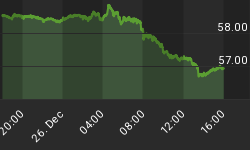One of the most salient features of the market environment of recent months is the evolution of investor psychology. From March through May, stocks experienced a classic internal correction in which the most overbought and overvalued stocks declined while fairly valued large caps remained buoyant.
The rationale behind this strategy was the determination of money managers not to give back the big gains from the 2013 rally. Instead of selling everything they simply moved money out of last year's top-performing (but overvalued) small caps and moved money into stocks sporting lower P/E ratios and higher dividend yields. Consequently, the benchmark S&P 500 large cap index held up well throughout the March-May correction, as did the Dow Jones Industrial Average.
The trading pattern which emerged in the S&P during this internal correction was a lateral trading range. Many investors have difficulty evaluating trading ranges, although it's a fairly straight-forward procedure. The most important thing to consider isn't the progression of prices within the range, but the tenor of investor psychology while the range is taking shape. This is one of the ways which makes it easier to predict which direction prices will break out from once the lateral trend has run its course.

During the last few weeks investor sentiment has shown a remarkable neutrality or lack of commitment. Small investors have been reluctant to take a stand, whether bullish or bearish. Yet while the lateral trend was unfolding in the Dow and S&P, corporate insiders displayed a remarkable bullish bias. Insider purchases of shares in May hit their highest levels since October, the time of a previous interim low. So while small investors were too gun shy to buy, insiders were buying shares of their own companies with both hands.

Our Composite Gauge also suggested that "smart money" traders were positioned for an upside breakout from the trading range. This indicator, which combines OEX put-call data with insider buying and other sentiment measures, was closer to the bullish end of the spectrum in the weeks preceding the breakout. True to form, the market eventually broke out above the top end of its multi-week trading range just as the smart money apparently predicted.
As discussed previously, we need to see the 10-day moving average of the Composite Gauge hit a reading of 45 or higher in order to signal the arrival of a frothy market. This would also tell us that a top could be imminent, at least short-term. The indicator is currently at about 40 and is inching closer to the critical 45 level. It's not there yet, however, so the market could still make some additional gains before this indicator signals that smart money have started pulling in their horns.
Another expression of Wall Street money managers' stubborn refusal to give up the ghost is reflected in the S&P open-close indicator. This indicator is simply a cumulative graph showing the opening hour of trading each day for the SPX along with the closing hour. The theory behind it is that, in a well-established bull market, the opening hour should show a tendency to move higher on most days. This is a simple measure of the market's forward momentum. What's amazing about the following graph is that during the entirety of the March-May internal correction, the SPX continued to show a measure of forward momentum in terms of its opening hour performance. This explains how the S&P was able to remain so buoyant during the internal correction period.

Meanwhile the closing hour component of this indicator was in negative territory throughout much of the last couple of months. In May, however, it started gaining upside traction and eventually broke back into positive territory. The assumption behind this is that "smart money" traders were gradually accumulating large cap stocks and thus the market was still on a bullish footing.
As strong as the stock market has been lately, many are wondering if the trend will remain up through year end or if there's still a chance for a sell-off. Many investors consider the market to be overvalued and have launched what amounts to a buyer's strike in the wake of the latest rally. These investors are nonetheless salivating at the prospect of being able to buy in at lower level if given the opportunity. Their hope is that this occurs sometimes between now and this fall when the major Kress cycles are scheduled to bottom.
Keeping in mind that the market is apt to disappoint the majority's wishes, there's still the chance that this summer could witness an important correction. The odds of this occurring will increase if the major indices continue rallying from here and become severely over-extended from their 200-day moving averages. This would put the market in a technically vulnerable position.
Under this scenario, a potential repeat of the August-September 1998 mini-bear market would be possible. For now, though, consider that the market's main trend is up as the bulls still hold sway.
















